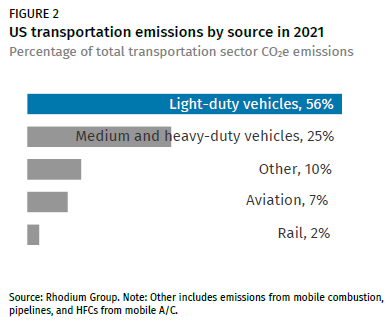Projecting Vehicle Sales: A Review of Light-Duty Vehicle Adoption Models
One challenge to transportation decarbonization is the slow stock turnover of vehicles. It is important to understand consumer adoption of ZEVs to inform policy.
To meet its nationally determined contribution under the Paris Agreement, the US must reduce greenhouse gas (GHG) emissions by 50-52% below 2005 levels by 2030. Achieving this ambitious goal will require a concerted effort across all levels of government and in all sectors of the economy (Larsen, et al., 2021). Furthermore, this interim target only gets the country halfway toward its goal of net-zero greenhouse gas emissions by 2050 (Department of State and Executive Office of the President, 2021).
Though the power sector had historically been the largest GHG emitter, since 2016, the transportation sector has claimed that title (Figure 1). Moreover, while the Inflation Reduction Act (IRA) is projected to decrease economywide GHG emissions to 32-42% below 2005 levels, much of that reduction comes in continued gains in the power sector rather than substantial reductions in other parts of the economy (Larsen, et al., 2022). While we project power sector emissions fall to 69-79% below 2005 levels, transportation emissions only drop to 18-26% below 2005 levels. Further, even with the incentives provided in the IRA, we expect the transportation sector to remain the highest-emitting sector through 2035. Put another way, there are plenty of emissions left to cut in the transportation sector, and additional policy action will be necessary to drive down transportation sector emissions and keep the US on its decarbonization pathway through 2030 and beyond.
The transportation sector is diverse in its energy use and sources of emissions, but the largest share—more than half—comes from the combustion of liquid fuels in light-duty vehicles (LDV) (Figure 2). Though reductions will be required across the board in a net-zero transportation sector, commercial technologies (like electric vehicles and other zero-emitting vehicles, or ZEVs) are most widely available today to reduce emissions from LDVs, making them a promising place to work on driving further emissions reductions.

Progress is already underway on this front. The Energy Information Administration (EIA) reported that electric vehicle sales represented nearly 5% of total LDV sales in the fourth quarter of 2021, up from less than 1% just a few years prior (Dwyer, 2022). But the LDV fleet faces a stock turnover problem: in any given year, only a small percentage of LDVs on the road are new, such that even if 100% of LDV sales are ZEVs starting in 2030, the fleet wouldn’t be fully ZEV until after 2040 (Larsen, King, Kolus, & Wimberger, 2021). Every vehicle sale today matters, given how long it will be on the road.

Given this context, it is critically important to understand consumer adoption of zero-emitting LDVs to inform policy design to further this goal. Of course, the price of owning and operating a vehicle is a critical factor in a consumer’s vehicle purchasing choice. But, depending on the analysis, cost parity between some ZEVs and their conventional internal combustion engine (ICE) counterparts is either fast approaching or has already been achieved (Lutsey & Nicholas, 2019; Harto, 2020; Orvis, 2022). Since ZEV sales shares are still low relative to incumbent ICE vehicles, further explanation is necessary to understand what drives this outcome. Numerous methodological approaches have been developed and deployed in a wide range of consumer adoption models that seek to inform this understanding further.
This study seeks to inform policymakers and the modeling community by reviewing the range of consumer adoption modeling approaches used in projecting future ZEV sales. The study first reviews three main categories of consumer adoption techniques—market diffusion models, consumer choice models, and agent-based models—and explains their basic function and the strengths and weaknesses of each approach. We then dive deeper into specific consumer choice models used in policy-relevant modeling contexts. Finally, we offer some concluding thoughts.